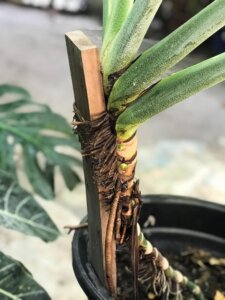Basic Information
The Monstera Pinnatipartita is a captivating tropical plant, renowned for its intricate leaf patterns and ability to climb. Originating from the dense rainforests of South and Central America, it adds a touch of exotic elegance to indoor spaces. Understanding its specific needs is key to ensuring this plant not only survives but thrives in a home environment.



Light
Monstera Pinnatipartita needs bright but indirect light to thrive. It needs at least six hours of such light to grow well. Direct sunlight can harm its leaves, while too little light can result in smaller and sparse-looking leaves. Place the plant near an east- or west-facing window with thin curtains to provide it with ideal lighting conditions, sheer curtains. This will provide a balance of brightness without the harshness of direct sunlight.
Water
Watering requirements for Monstera Pinnatipartita are dependent on the season. During the warmer months, it is recommended to water your plant once a week, making sure that the top layer of soil is slightly dry before the next watering. In the colder months, it’s essential to reduce the frequency of watering to avoid root rot. Consistency is key, so it’s best to establish a routine based on the season and check the soil’s moisture level to maintain the plant’s health.
Tip: Use a moisture meter to get accurate readings deeper in the pot. If the soil is not well aerated, the plant’s roots can become soaked while the surface is completely dry. Index 3-4 indicates a suitable humidity level.
Soil
For Monstera Pinnatipartita plant’s optimal growth, use soil with good drainage and moisture retention. Its pH level should be between 5 and 7.5, achieved by using a soil mix of peat moss, perlite, and orchid bark. This provides nutrients and proper aeration and prevents root diseases.
Tip: Use a moss pole for support and added nutrients as the plant grows upward.
Temperature
The temperature range for Monstera Pinnatipartita should mirror its tropical origins. Ideally, maintain temperatures between 65-81°F (18-27°C). The plant is sensitive to sudden temperature changes and cold drafts, so placement away from air conditioners and cold windows is vital. During winter, ensure the environment doesn’t fall below 50°F (10°C) to avoid stunting its growth.
Humidity
High humidity levels, preferably over 60%, are vital for Monstera Pinnatipartita, reflecting its rainforest habitat. In drier home environments, this can be achieved by using humidifiers, placing the plant in naturally humid rooms like bathrooms, or setting it on a pebble tray. Grouping it with other plants can also create a microclimate with higher humidity, which is beneficial for its growth.
Fertilizer
Fertilization is essential for the growth of Monstera Pinnatipartita, especially during the spring and summer. A balanced, water-soluble fertilizer should be applied every month, preferably with a higher nitrogen ratio. A slow-release balanced 20-20-20 liquid fertilizer would be ideal for your plant. This will provide the necessary nutrients for leaf development. However, during the dormant winter months, reducing or stopping fertilization is advisable. This will align with the plant’s natural growth cycle and ensure healthy growth in the following season.
Growth Rate
Monstera Pinnatipartita is known for its moderate to fast growth rate, with the potential to extend 1-2 feet annually in optimal conditions. Its climbing nature means it requires physical support like a moss pole or trellis, which also encourages healthy growth and mimics its natural climbing tendency in the wild.
Pet Safety
Monstera plants contain mildly toxic calcium oxalate crystals that can cause mouth and GI irritation when ingested. Keep the plant in a safe place away from pets and young children to avoid health issues.
Grow in Semi-Hydro
- Monsteras, known for their robust growth and iconic split leaves, flourish in semi-hydroponics systems like LECA/Pon, thanks to their adaptive root systems and love for moisture.
- Transitioning Monstera to semi-hydroponics is effective with a Nutrient Stagnant Wicking (NSW) setup, ensuring a stable and efficient growth environment.
- In LECA/Pon, Monstera roots quickly adjust, overcoming any initial challenges with root adaptation in the NSW system.
- A nutrient mix with a concentration of about 800-1000ppm is ideal for fertilizing Monsteras in semi-hydro setups.
- Monsteras are adaptable to various temperature and humidity conditions, making them suitable for growth in diverse indoor environments.
- Ongoing care includes regular monitoring of the water level in the reservoir and periodic flushing of the system to promote healthy and continuous growth.
Tips
- Position to receive bright, indirect sunlight, avoiding direct sun exposure.
- Establish a regular watering routine, adjusting for seasonal changes.
- Utilize a well-draining soil mixture that retains some moisture.
- Maintain a warm, stable temperature environment.
- Increase humidity using humidifiers, pebble trays, or grouping with other plants.
- Fertilize monthly with a balanced, water-soluble fertilizer during the growing season.
- Provide support for climbing, such as a moss pole.
- Repot every 2-3 years, or when the plant outgrows its current pot.
- Regularly inspect for pests and diseases, treating them promptly if needed.
- Keep the plant away from pets and children due to its mild toxicity.
Growing a Monstera Pinnatipartita requires mimicking its tropical habitat. With proper care for light, water, soil, temperature, humidity, and nutrition, it can thrive indoors.
Happy planting! 🌱


